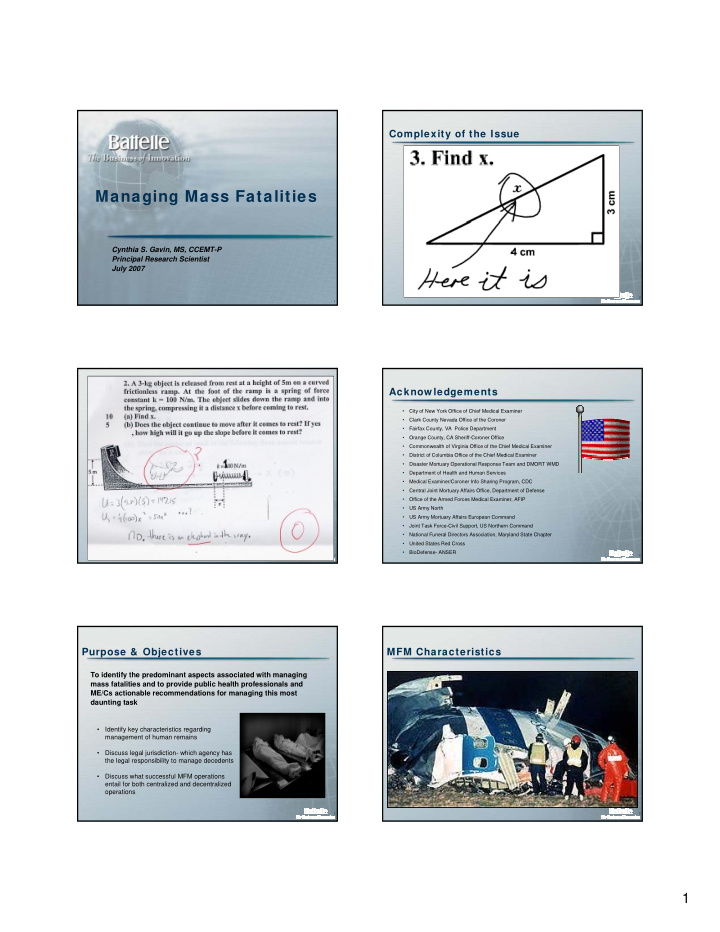



Complexity of the Issue Managing Mass Fatalities Cynthia S. Gavin, MS, CCEMT-P Principal Research Scientist July 2007 2 1 Acknow ledgements • City of New York Office of Chief Medical Examiner • Clark County Nevada Office of the Coroner • Fairfax County, VA Police Department • Orange County, CA Sheriff-Coroner Office • Commonwealth of Virginia Office of the Chief Medical Examiner • District of Columbia Office of the Chief Medical Examiner • Disaster Mortuary Operational Response Team and DMORT WMD • Department of Health and Human Services • Medical Examiner/Coroner Info Sharing Program, CDC • Central Joint Mortuary Affairs Office, Department of Defense • Office of the Armed Forces Medical Examiner, AFIP • US Army North • US Army Mortuary Affairs European Command • Joint Task Force-Civil Support, US Northern Command • National Funeral Directors Association, Maryland State Chapter • United States Red Cross • BioDefense- ANSER 3 4 Purpose & Objectives MFM Characteristics To identify the predominant aspects associated with managing mass fatalities and to provide public health professionals and ME/Cs actionable recommendations for managing this most daunting task • Identify key characteristics regarding management of human remains • Discuss legal jurisdiction- which agency has the legal responsibility to manage decedents • Discuss what successful MFM operations entail for both centralized and decentralized operations 5 6 1
MFM Characteristics MFM Characteristics 7 8 MFM Characteristics MFM Characteristics 9 10 Jurisdiction Typical Jurisdiction of ME/C- • ME/C investigate cases of persons who die within their local jurisdiction for criminal violence; by casualty or by suicide; suddenly, when in apparent good health; when unattended by a physician; in a correctional facility; or in any suspicious or unusual manner. The Office also investigates when an application is made pursuant to law for a permit to cremate the body of a person • 10 USC, 1471- to conduct scientific forensic investigations for determining the cause and manner of death of members of the Armed Forces on active duty or on active duty for training and, under specific circumstances, civilians who die in areas of exclusive federal jurisdiction Atypical Jurisdiction of ME/C- Emergency Health Powers Act- • To assist State authorities with developing an appropriate response to a public health emergency in light of a possible bioterrorist attack and naturally occurring epidemic. A public health emergency is an occurrence or imminent threat of an illness or health condition or an incident that results in a large number of deaths in an affected population 11 12 2
Jurisdiction Jurisdiction Death investigation Death investigation systems vary systems vary depending on State depending on State and/or county and/or county • 22 Medical Examiner • 22 Medical Examiner Systems Systems • 18 mixed Medical • 18 mixed Medical Examiner/Coroner Examiner/Coroner Systems Systems • 11 Coroner Systems. • 11 Coroner Systems. CDC’s Medical Examiner & Coroner Information Sharing Program (2003) 13 14 Figure # The Medical Examiner Special Operations Response Team Approach to Managing Chemically Contaminated Remains Centralized Management Approach Personal Effects Personal Effects Incident Incident Depot Depot Staff Staff Characterization Characterization Management Management Family Assistance Family Assistance Center Center Incident Specific Incident Specific Staff Staff Planning Planning Safety Safety Daily Case load Daily Case load Recovery Incident Incident Transport/ Transport/ Morgue Final Final Morgue Transport/ Transport/ of Morgue Storage Disposition Morgue Storage Ops Storage Disposition Remains Ops Storage Figure # 15 16 Decentralized Management Approach Decentralized Management Approach LCP LCP REMAINS HOLDING REMAINS HOLDING REMAINS HOLDING REEFER REEFER REEFER REMAINS HOLDING REMAINS HOLDING REMAINS HOLDING REEFER REEFER REEFER LCP LCP REMAINS HOLDING REMAINS HOLDING REMAINS HOLDING REEFER REEFER REEFER REMAINS HOLDING REMAINS HOLDING REMAINS HOLDING REEFER REEFER REEFER LCP REMAINS HOLDING REMAINS HOLDING REMAINS HOLDING REEFER REEFER REEFER LCP LCP REMAINS HOLDING REMAINS HOLDING REMAINS HOLDING REEFER REEFER REEFER REMAINS HOLDING REMAINS HOLDING REMAINS HOLDING REEFER REEFER REEFER 17 18 3
Actionable Recommendations Actionable Recommendations Initial Response Response • Local ME/C must have jurisdiction and take ownership to • Identify required targeted capabilities manage naturally occurring outbreaks • Establish operational infrastructure • Characterize the incident – Protect staff & provide guidance • Determine management approach – Requires ME/C staff change in roles and responsibilities • Shift all existing resources towards performing only the – Requires managing outside resources most vital fatality processing functions • Work with mayor, public health, religious community, funeral – Recovery directors, and other public and private agencies to modify public – Abbreviated processing to secure expectation regarding fatality management operations and final disposition decedent’s identification – Temporary storage On-going Response – Tracking • Incorporate efforts that hasten final disposition without ever • Establish the Family Assistance Center (FAC) sacrificing accuracy in deriving victim identification 19 20 Provide Guidance Final Thoughts Before Designing the Incident Specific plan • Are we truly streamlining the process or are we trying to do the same thing we always do more quickly? • Do we have the resources to safely process remains? Small or larger numbers? • What level of risk are we willing to accept as a collective body? - Political - Religious - Public perception/media - Public health - Legal • To what extent do families get to influence the process? 21 22 Final Thoughts- Processing Final Thoughts- Processing 23 24 4
Final Thoughts- Temporary Storage Final Thoughts- Temporary Storage 25 26 Final Thoughts- Final Disposition Final Thoughts- Temporary Interment 27 28 Final Thoughts- External Agencies Final Thoughts- Family Members 29 30 5
Final Thoughts- Service Members Cynthia S. Gavin 410-306-8667 gavinc@battelle.org To obtain a copy of • The Capstone Document- Mass Fatality Management for Incidents Involving Weapons of Mass Destruction, by US Army RDECOM Military Improved Response Program http://www.edgewood.army.mil/hld/dl/MFM_Capstone_August_2005.pdf • White Paper- Morgue Operations, Identification, and Command and Control of Mass Fatalities resulting from a PI event in the US http://www.icfa.org/pdf/white_paperMFM.pdf 31 32 6
Recommend
More recommend